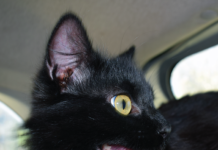Q.) Dear Elizabeth: I sometimes read in the news about rabies spreading through certain parts of the country. Is this due to a new virus? How dangerous is it? How is it spread? Do I need to take extra steps to keep my cat safe?
Thanks for your good questions. I’m happy to share what I’ve learned from my pals at the FHC and to tell you that the short story is: Don’t panic! Rabies is in the family of RNA viruses (Rhabdoviridae) and the genus, Lyssavirus. Rabies exists nearly everywhere although some areas (including New Zealand; parts of the Caribbean, Scandinavia, and British Isles; Japan; and Hawaii) are thought to be free of the virus.
In the U.S. — as in most of the Northern Hemisphere — rabies is a disease of wildlife which occasionally spills over to infect domestic animals and humans. Infection of our pet cats and dogs occurs when unvaccinated animals come into contact with infected wild animals; vaccination provides an important protection to our pets and makes an effective barrier between wildlife rabies and humans.
All warm-blooded animals are susceptible to rabies; however, the virus in a particular geographic area is usually a distinct genetic variant that has adapted to preferentially infect a single dominant reservoir host. That’s why you’ll hear about so-called ‘raccoon rabies’ in the Eastern US, and ‘skunk rabies’ on the West coast. The reservoir host species is endemically infected, meaning that infection always exists in the population at some frequency. Infection in the reservoir host population tends to have a cyclic pattern, with numbers of animals infected waxing and waning over time.
Spill-over to other species from the reservoir host population tends to be sporadic. Infection depends on contact between the primary host species and a susceptible animal. Once infection passes from the primary host into another species, it tends to be a dead-end; this means that the newly infected animal is unlikely to be a source of sustained virus spread to other members of its species. For example, if a rabid raccoon on the East coast (infected with the raccoon variant rabies virus) bites a fox, the virus remains a ‘raccoon variant’ and does not change to preferentially infect foxes. Raccoon variant rabies will tend to quickly die out in the fox population.
Our advice to cat owners is clear and unchanged:
(1) Be certain to keep your cat’s rabies vaccination up to date: no matter where you live!
(2) If you live in a rabies-endemic area that is experiencing a high number of cases in the wildlife population, consider keeping your cat indoors.
(3) As always, be mindful of wildlife that is acting abnormally.
I hope that this helps clear up your questions. Love, Elizabeth



